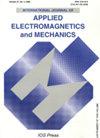Neural metamodels and transfer learning for induction heating processes (TEAM 36 problem)
IF 0.7
4区 工程技术
Q4 ENGINEERING, ELECTRICAL & ELECTRONIC
International Journal of Applied Electromagnetics and Mechanics
Pub Date : 2023-11-21
DOI:10.3233/jae-230087
引用次数: 0
Abstract
The authors explore the possibility of applying a convolutional Naeural Network (CNN) to the solution of coupled electromagnetic and thermal problem, focusing on the classical problem of induction heating systems, traditionally solved by resorting to Finite Element (FE) models. In fact, FE modelling is widely used in the design of induction heating systems due its accuracy, even if the solution of a coupled nonlinear problem is expensive in terms of computational time and hardware resources, notably in 3D analysis. A model based on CNN could be an interesting alternative; in fact, CNN is a learning model selected for its excellent ability to converge, even when trained with a limited dataset. CNNs are able to treat images as input and they are used here as follows: given a temperature map in the workpiece, identify the corresponding vector of current, frequency and process heating time; this mapping is a model of the inverse induction heating problem. Specifically, we consider as an example the induction heating of a cylindrical steel billet, made of C45 steel, placed in a solenoidal inductor coil exhibiting the same axial length of the billet (TEAM 36 problem). A thorough heating process is usually applied before hot working of the billet, as in an extrusion process, but this methodology can be applied also in the design of induction hardening processes. First, a CNN has been trained from scratch by means of a dataset of FE solutions of coupled electromagnetic and thermal problems. For the sake of a comparison, a transfer learning technique is applied using GoogLeNet, i.e. a Deep Convolutional Neural Network able to classify images: starting from the pre-trained GoogLeNet, its training has been subsequently refined with the dataset of solutions from FE analyses. When the training dataset contains a limited number of samples, GoogleNet shows good accuracy in predicting the process parameters; in the case of a high number of samples in the training set, namely beyond a threshold like e.g. 1500, both CNNs show good accuracy of the result.感应加热过程的神经元模型和迁移学习(TEAM 36题)
作者探讨了将卷积神经网络(CNN)应用于求解电磁和热耦合问题的可能性,重点是感应加热系统的经典问题,传统上采用有限元(FE)模型来解决。事实上,有限元建模由于其准确性被广泛应用于感应加热系统的设计中,即使耦合非线性问题的求解在计算时间和硬件资源方面是昂贵的,特别是在三维分析中。基于CNN的模型可能是一个有趣的选择;事实上,CNN是一种学习模型,因为它具有出色的收敛能力,即使在使用有限的数据集进行训练时也是如此。cnn能够将图像作为输入,它们在这里的用途如下:给定工件的温度图,识别相应的电流、频率和工艺加热时间矢量;该映射是感应加热逆问题的一个模型。具体来说,我们将C45钢制成的圆柱形钢坯的感应加热作为一个例子,放置在具有相同轴向长度的钢坯的螺线管电感线圈中(TEAM 36问题)。在对坯料进行热加工之前,通常要进行彻底的加热过程,如在挤压过程中,但这种方法也可以应用于感应硬化过程的设计。首先,利用耦合电磁和热问题的有限元解数据集从头开始训练CNN。为了进行比较,使用GoogLeNet应用迁移学习技术,即能够对图像进行分类的深度卷积神经网络:从预训练的GoogLeNet开始,随后使用FE分析的解决方案数据集对其训练进行改进。当训练数据集包含有限数量的样本时,GoogleNet在预测过程参数方面表现出良好的准确性;在训练集中样本数量较多的情况下,即超过阈值(例如1500),两种cnn都显示出良好的结果准确性。
本文章由计算机程序翻译,如有差异,请以英文原文为准。
求助全文
约1分钟内获得全文
求助全文
来源期刊
CiteScore
1.70
自引率
0.00%
发文量
100
审稿时长
4.6 months
期刊介绍:
The aim of the International Journal of Applied Electromagnetics and Mechanics is to contribute to intersciences coupling applied electromagnetics, mechanics and materials. The journal also intends to stimulate the further development of current technology in industry. The main subjects covered by the journal are:
Physics and mechanics of electromagnetic materials and devices
Computational electromagnetics in materials and devices
Applications of electromagnetic fields and materials
The three interrelated key subjects – electromagnetics, mechanics and materials - include the following aspects: electromagnetic NDE, electromagnetic machines and devices, electromagnetic materials and structures, electromagnetic fluids, magnetoelastic effects and magnetosolid mechanics, magnetic levitations, electromagnetic propulsion, bioelectromagnetics, and inverse problems in electromagnetics.
The editorial policy is to combine information and experience from both the latest high technology fields and as well as the well-established technologies within applied electromagnetics.

 求助内容:
求助内容: 应助结果提醒方式:
应助结果提醒方式:


